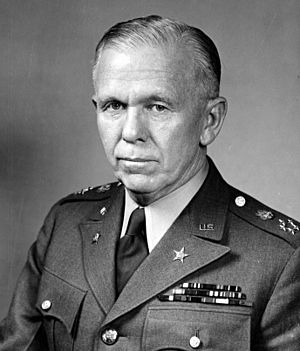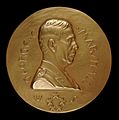George Marshall facts for kids
Quick facts for kids
George C. Marshall
|
|
|---|---|

Official portrait, 1946
|
|
| 3rd Secretary of Defense | |
| In office 21 September 1950 – 12 September 1951 |
|
| President | Harry S. Truman |
| Deputy | Stephen Early Robert A. Lovett |
| Preceded by | Louis A. Johnson |
| Succeeded by | Robert A. Lovett |
| 10th President of the American Red Cross | |
| In office 1 October 1949 – 1 December 1950 |
|
| President | Harry S. Truman |
| Preceded by | Basil O'Connor |
| Succeeded by | E. Roland Harriman |
| 2nd Chairman of the American Battle Monuments Commission | |
| In office January 1949 – 16 October 1959 |
|
| Preceded by | John J. Pershing |
| Succeeded by | Jacob L. Devers |
| 50th Secretary of State | |
| In office 21 January 1947 – 20 January 1949 |
|
| President | Harry S. Truman |
| Deputy | Dean Acheson Robert A. Lovett |
| Preceded by | James F. Byrnes |
| Succeeded by | Dean Acheson |
| United States Special Envoy to China | |
| In office 20 December 1945 – 6 January 1947 |
|
| President | Harry S. Truman |
| Preceded by | Position established |
| Succeeded by | Position abolished |
| 15th Chief of Staff of the United States Army | |
| In office 1 September 1939 – 18 November 1945 |
|
| President | Franklin D. Roosevelt Harry S. Truman |
| Deputy | Lorenzo D. Gasser William Bryden |
| Preceded by | Malin Craig |
| Succeeded by | Dwight D. Eisenhower |
| Personal details | |
| Born |
George Catlett Marshall Jr.
31 December 1880 Uniontown, Pennsylvania, U.S. |
| Died | 16 October 1959 (aged 78) Walter Reed Army Medical Center |
| Resting place | Arlington National Cemetery |
| Political party | None |
| Spouses |
Lily Carter Coles
(m. 1902; died 1927)Katherine Boyce Tupper Brown
(m. 1930) |
| Education | Virginia Military Institute |
| Civilian awards | Nobel Peace Prize Congressional Gold Medal Charlemagne Prize Complete list |
| Signature |  |
| Military service | |
| Branch/service | United States Army |
| Years of service | 1902–1959 |
| Rank | |
| Commands | Chief of Staff of the United States Army Deputy Chief of Staff of the United States Army 5th Brigade, 3rd Infantry Division Fort Moultrie and District I, Civilian Conservation Corps Fort Screven and District F, Civilian Conservation Corps 8th Infantry Regiment |
| Battles/wars | |
| Military awards | Army Distinguished Service Medal (2) Silver Star Croix de Guerre Complete list |
| College football career | |
| VMI Keydets | |
| Position | Left Tackle |
| Career history | |
| College | VMI (1900) |
| Career highlights and awards | |
|
All-Southern (1900)
|
|
George Catlett Marshall Jr. (December 31, 1880 – October 16, 1959) was an important American army officer and statesman. He rose through the United States Army to become the top military leader, known as the Chief of Staff of the U.S. Army. He served under Presidents Franklin D. Roosevelt and Harry S. Truman.
After his military career, Marshall became Secretary of State and later Secretary of Defense under President Truman. Winston Churchill called Marshall the "organizer of victory" because of his amazing leadership during World War II. He helped the Allied forces win the war.
As Secretary of State, Marshall created a plan to help Europe recover after the war. This plan, called the Marshall Plan, helped many countries rebuild their economies. For this important work, he received the Nobel Peace Prize in 1953. He is the only Army general ever to win this award.
Contents
Early Life and Education
George Catlett Marshall Jr. was born in Uniontown, Pennsylvania. He was the youngest of three children. His parents were George Catlett Marshall and Laura Emily Marshall.
From a young age, George wanted to be a soldier. He decided to attend the Virginia Military Institute (VMI) for his education. His brother, who also went to VMI, didn't think George would do well. But George was determined to prove him wrong. He enrolled at VMI in December 1897 when he was 16 years old. His mother sold some land to help pay for his schooling.
At VMI, Marshall was always excellent in military training. He became the "first captain," which was the highest rank a cadet could achieve. He also played football as an offensive tackle. In 1900, he was chosen for the All-Southern team. He graduated from VMI in 1901.
Military and Government Career
Marshall served in the U.S. Army both at home and overseas. He started as a platoon leader and company commander in the Philippine–American War. He was a top student at the United States Army Command and General Staff College in 1907. He also graduated first in his class at the United States Army War College in 1908.
When the U.S. entered World War I in 1917, Marshall helped organize and train soldiers. He also planned important combat operations in France, like the Meuse–Argonne offensive. After the war, he worked closely with John J. Pershing, who was the Army Chief of Staff.
Marshall later taught at the United States Army War College. In 1927, he became assistant leader of the Army's United States Army Infantry School. There, he updated how the army worked, which was very helpful during World War II.
In 1939, Marshall became the Chief of Staff of the United States Army. This was the highest-ranking officer in the U.S. Army. He worked with Secretary of War Henry L. Stimson to greatly expand the U.S. military. He was promoted to a five-star rank as General of the Army. Marshall helped coordinate all the Allied operations in Europe and the Pacific during World War II.
After the war ended in 1945, Marshall retired from active service. However, he remained on active duty because of his five-star rank. From 1945 to 1947, he served as a special envoy to China. He tried to help the different groups in China form one government, but he was not successful.
From 1947 to 1949, Marshall served as United States Secretary of State. In this role, he created the Marshall Plan. This plan provided billions of dollars to help rebuild Europe after World War II. This effort earned him the 1953 Nobel Peace Prize.
After being Secretary of State, Marshall led the American Red Cross. He then became United States Secretary of Defense at the start of the Korean War. He worked to rebuild the military's confidence after World War II. He also helped prepare the military for the Cold War. After his time as Secretary of Defense, Marshall retired to his home in Virginia.
Death and Burial
George Marshall passed away on October 16, 1959, in Washington, D.C. He had a special military funeral, as he preferred a simple ceremony. His body lay in state at the Washington National Cathedral for 24 hours.
Marshall was buried at Arlington National Cemetery. He was laid to rest next to his first wife and her mother. His second wife was also buried with him later. His headstone lists his important roles: "Chief of Staff U.S. Army, Secretary of State, President of American Red Cross, Secretary of Defense."
Reputation and Legacy
George Marshall is remembered as a very important and selfless American leader during the early Cold War. President Truman once said that Marshall was the greatest American contributor of his time. Truman praised Marshall's skills as an administrator and his knowledge of military affairs.
Marshall is most famous for the Marshall Plan. This plan provided a lot of aid to help European countries recover after World War II. It helped restart their economies and rebuild their destroyed cities.
Tributes and Memorials
Many places and organizations honor General Marshall. The George C. Marshall Foundation keeps his official papers and other important documents from the 20th century. The George C. Marshall International Center preserves his home, Dodona Manor, as a museum. It also offers educational programs about his life and leadership.
Several streets are named after him, including some in Germany. On April 30, 1998, the first public statue of General Marshall in Europe was unveiled in Germany. It shows him walking across a bronze bridge, symbolizing his efforts to build friendships and alliances.
Civilian Honors
George Marshall received many awards for his work outside the military:
| Date | Awarding Organization | Award |
|---|---|---|
| 1943 | Time magazine | Man of the Year |
| 1946 | United States Congress | Congressional Gold Medal |
| 1947 | Time magazine | Man of the Year |
| 1953 | Norwegian Nobel Committee | Nobel Peace Prize |
| 1959 | Aachen, Germany | Charlemagne Prize |
Images for kids
-
Army Chief of Staff Marshall with Secretary of War Henry Stimson.
-
Army Chief of Staff George C. Marshall with Chief of the Army Air Force General Henry "Hap" Arnold in England on July 23, 1945.
-
General Marshall with Chiang Kai-shek and Zhou Enlai in China, 1946.
-
General Marshall being sworn in as Secretary of State by Chief Justice Fred Vinson in the Oval Office on January 21, 1947.
-
Army Chief of Staff George Marshall with Air Force Chief of Staff Gen. "Hap" Arnold accompanying Brig. Gen. James H. Doolittle as he receives the Medal of Honor from President Franklin Roosevelt. April 18, 1942.
-
Oveta Culp Hobby being sworn in as the first leader of the WAAC. General George C. Marshall and Secretary of War Henry L. Stimson witness the ceremony. May 16, 1942.
-
General Marshall greets Major General John R. Deane and Brigadier General Stuart Cutler while arriving at Potsdam, Germany on July 15, 1945.
-
George C. Marshall shaking hands with his predecessor James F. Byrnes, as President Truman looks on, at the White House, January 21, 1947.
-
Secretary of State Marshall pointing out landmarks at Mount Vernon to Mexican President Miguel Aleman. April 1947.
-
Secretary of Defense Marshall with President Truman and Princeton University President Harold W. Dodds at the Library of Congress. May 17, 1950.
-
Secretary of Defense George C. Marshall with President Truman, Secretary of State Dean Acheson, and Prime Minister of France Rene Pleven at the White House on January 29, 1951.
-
President Harry S. Truman awarding General Marshall an Oak Leaf Cluster to his Distinguished Service Medal on November 26, 1945.
See also
 In Spanish: George Marshall para niños
In Spanish: George Marshall para niños




























